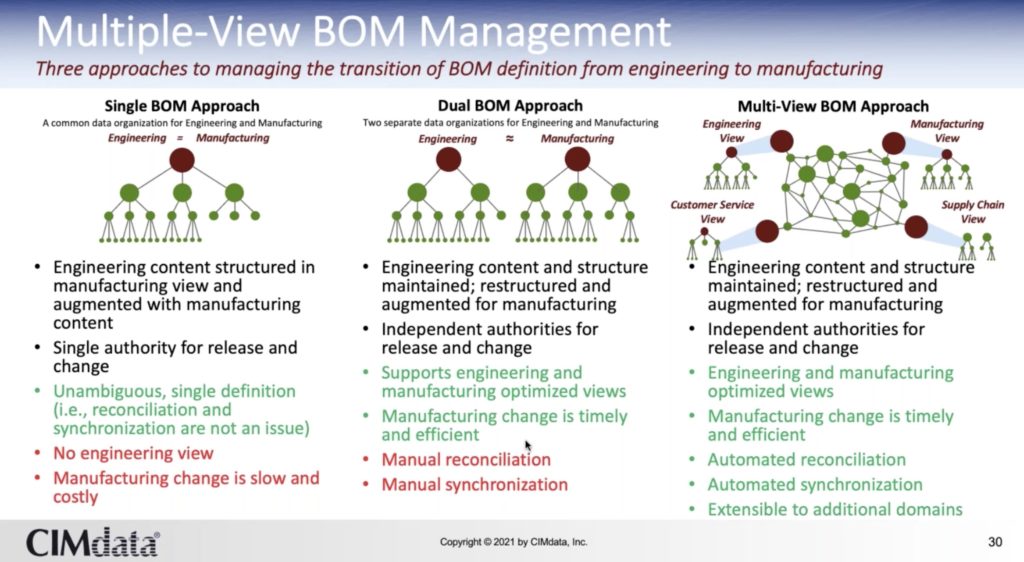
In order to remain competitive in the manufacturing industry, it is important to continually explore ways to improve efficiency and reduce costs. One way to achieve this is through the implementation of data and process management strategies to streamline data handover and information flow between two major business functions – engineering and manufacturing. As more manufacturing companies are placing data in the middle of their digital transformation strategies, the discussion about how to handle the Bill of Materials and all related information is becoming more urgent than ever. The manufacturing process is dependent on how efficiently the manufacturing company can manage the data. In this blog, I’d like to guide you through some of my ideas on how to implement a multi-view BOM approach. Stay competitive, and keep reading
In my article earlier this week, I talked about Digital BOM and the need to start a digital transformation in product lifecycle management. Check my article – From EBOM and MBOM to Digital BOM. Check this out and draw your conclusion.
What is Multi-View BOM?
I’d like to bring a slide presented by CIMdata about multiple BOM management approaches – Single BOM, Dual BOM, Multi-View BOM. Please check it out.

I like the slide because it clearly shows the different conceptual approaches in the way data can be managed. On the left side, you can see a single structure. According to CIMdata, it was the time when MRP II (or later ERP) systems were dominant and controlled the product information completely. The data was delivered to manufactured and only a single BOM was maintained. You can see the duopoly of having BOMs co-existing with many synch processes going in between. In my view, the majority of large PLM implementations are actually following this strategy. The 3rd option called “Multi-View BOM” presents an approach where data is presented as a graph with the ability to filter out a view and present it to people.
A very interesting thing I found with many companies that need to manage complex configurable products and manage MBOM (or planning BOM) using PLM systems. This is a very viable option for managing data, but it is a kind of a 2.5 option – a transition from 2 BOMs to multi-view BOMs.
According to CIMdata, a multi-view BOM is a strategy in which the foundation of the BOM is created from engineering BOM, but this content can be restructured and augmented for manufacturing. What does it mean in a pragmatic sense? It means that the manufacturing structure will be derived from the engineering BOM, but the data won’t be synced between two structures EBOM and MBOM.
I think the strategy is clear and the value is strong. It made me think about how such a solution can be implemented and what tools and technologies are needed to make it a viable solution. In my article today, I will touch on 3 options: (1) One System; (2) Multi-System Federation; (3) Service Augmentations.
One System
Multi-view BOM can be easily implemented using single data management system. To make it happen, the data model and product structure need to be flexible enough to present multiple dynamic structured filtering capabilities. Advanced PLM systems can do so for most of their parts. Although the devil is in detail and before you embark on such a single system implementation, you need to check carefully how flexible is data management engine is and its capabilities to work with multiple overlapped structures. From an application and platform standpoint, it usually means that the PLM system will be taking a lead on overall product structure data management. In such a scenario, the ERP role is silently supporting financials and basic inventory with master Item management and MBOMs mostly imported for the purpose of procurement planning.
Multi-System Federation
This is a very complex way, but in my view, this method is one of the most popular among large manufacturing companies implementing both PLM and ERP technologies today. The foundation of the implementation is the 2.5 BOMs option. The overall structure can be managed in the PLM system, but the ERP system will be getting access to this information via federation proxy access points. The most critical element of this implementation is the ability of the PLM system to manage such a complex data structure as multi-view BOM and ERP system is using federated integration layer to get access to this data in ERP environment. While data federation technology is mainstream and can be implemented, the weakest element of this implementation strategy is to have a PLM system capable to perform data management needed for multi-view BOM.
Service Augmentation
The last and, in my view, the most promising approach is to bring a modern data management approaches to manage multi-view product structure. Practically all existing PLM systems in the market today are built using traditional relational databases with the application of object modeler to create a desired data model flexibility and tools needed to manage the complexity of the multi-view BOM approach. Such relational databases are very weak when it comes to the management of complex relationships and linked graphs – links and structures usually create a lot of challenges for RDBMS and historically they are not performing well. A new approach here can be the usage of Graph databases or a combination of databases (polyglot persistence architecture) capable to create reach and efficient modeling capabilities. In the following blogs, I will speak more about this approach and will bring examples of implementations.
Conclusion
Multi-view BOM strategy is a super promising approach, which no doubt will lead towards future innovation in product lifecycle management and overall in engineering and manufacturing software. While most of the manufacturing companies are solely relying on mature legacy PLM software, the new approach in data management and tools development brings me to the point when I think future tech will have a competitive edge compared to existing data management platforms. Just my thoughts…
Best, Oleg
Disclaimer: I’m co-founder and CEO of OpenBOM developing a digital network-based platform that manages product data and connects manufacturers, construction companies, and their supply chain networks. My opinion can be unintentionally biased.
The post How To Implement Multi-view BOM Strategy? appeared first on Beyond PLM (Product Lifecycle Management) Blog.



Be the first to post a comment.